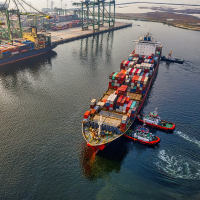- Archives
- 2023
Maritime Cluster Relatedness
Western European cities’ maritime business strength has undergone significant changes in the past two centuries. European cities have been serving as the regional gateway, e.g., Antwerp in 16th century, Amsterdam in 17th century, London in 18th century, and Le Havre and Hamburg in 19th century. Competitors from China, South Korea, Vietnam, India, and Brazil progressively captured the market share of cities in Europe. Nowadays, only Bremerhaven and Rotterdam secured an above average share of the regional port operations. Traditional port cities such as London and Amsterdam have transformed into service centres with a focus on providing professional maritime services.
Western European cities initially adopted the bottom-up governance model where private actors primarily govern coordinated initiatives within the cluster. The European Commission published the “Green Book on Maritime Europe” in 2006 bought the first step toward developing an EU global maritime strategy. Maritime policies in the EU place a premium on industry development and avoid assigning a specific role to a city. On the other hand, cities in China operate on a top-down policy structure, with governance as a moderator to address market inefficiencies such as excessive competition and extreme development status imbalances. The government plays an influential role in differentiating the city’s functions. For instance, the outline for the development of the GBA in 2019 proposed to bolster Hong Kong’s position as an international shipping hub with value-added services while enhancing Shenzhen and Guangzhou’s comprehensive transportation services through the enhancement of port and channel infrastructures.
Ship owning and ship management are closely related in Western Europe as many European cities have a long shipping history while shipbroking and ship finance are mostly related to Hong Kong in GBA as Hong Kong’s position as an international finance and shipping centre lays a strong regional competitive foundation. Hong Kong led the way to take advantage of the high value-added maritime service industry. Hong Kong government implemented an open and relaxed maritime policy, including tariff free, open ship registration, and allow private operators to run container terminals. Hong Kong is the only transhipment hub between China and foreign countries and assumed most port-related and shipping-related functions for decades. After the opening-up reform in 1978, Shenzhen and Zhuhai became special economic zones, and gradually taking up maritime and logistics functions which cultivated regional maritime business. Shenzhen and other cities in GBA started to benefit from the spill over from Hong Kong, and gradually expanded maritime businesses. Hong Kong still owns its advantage in the financial and legal systems, its competitiveness in ship finance and shipbroking remains prosperous.
Hong Kong and Shenzhen are clusters in two activities, i.e., ship management and agencies, and cargo forwarding services. For the uniqueness, Hong Kong is specialized in shipbroking and ship finance, and Shenzhen is specialized in terminal operating, ship owning and operating. To improve the advantages and strengthens of the specialized maritime cluster, policymakers should plan and conduct activities to develop the eco-system. The relatedness coefficients shed light on the closely related services to develop for enhancing the function and role of the maritime cluster. For instance, banking and legal services are beneficial for enhancing ship finance and ship brokerage services leading to the jointly appearance of the three mostly connected maritime industry sectors (i.e., ship finance, shipbroking, ship management and agency) in Hong Kong. It is essential for leading maritime cities to continuously cultivate their high-value-added maritime industries for the sustainable development of the region.
Reference: Dong Yang, Chengkun Li, Lu Li, Kee-hung Lai, Venus Lun, 2022, Maritime cluster relatedness and policy implications, Transport Policy, 128:76-88
LSCM – Venus Lun

